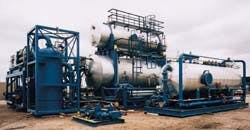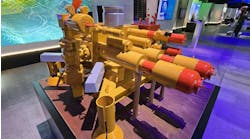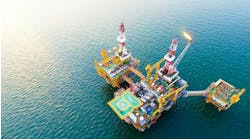Trials provide valuable pointers on tough North Sea developments
Jeremy Beckman
Editor, Europe
Pre-assembly of process equipment for the Hermod extended well test, onshore at Aberdeen.
As prospects for major oil discoveries in the North Sea recede, operators are reverting to the complex reservoirs they had left until a rainy day.
Producibility is their main concern, but there is no need to rush into the unknown: extended well tests lasting from 30 days to a year can answer many questions before committing to a full-scale development.
Extended well tests (EWTs) allow reservoir and well performance data to be acquired that aids prediction of future field performance more accurately than conventional well tests. EWTs also increase confidence concerning the extent of the reservoir's fluid mobility, well productivity and optimization of fluid processing.
Technology for analysis has advanced since the North Sea's first EWT in 1988 on Lasmo's Birch Field, but so has organization. There are now two consortia in Northwest Europe offering total project management for this type of test: TAP, comprising ABB Vetco Gray, Coflexip Stena Offshore, Schlumberger and Sedco Forex; and the Victoria Alliance, formed in July last year.
The main players in this alliance are Victoria Oilfield Developments (VOD), Diamond Offshore, Dresser and the Expro Group. They do not always work together, but they can also bring in outside expertise. As a unit, they claim complete EWT capability from reservoir to refinery, including the ability to drill and complete wells as well as providing subsea, process, data acquisition and export facilities.
Norway catches on
Most recent EWT assignments in Northwest Europe have come from the UK Central North Sea and areas close to the Shetlands. However, Norsk Hydro has just awarded contracts for a test on its undeveloped Hermod oilfield in the Norwegian Sea.
Another extended test is likely soon on the high pressure and temperature Smoerbukk reservoir, part of the sgard development in Norway's Haltenbanken. And Statoil, Hydro and Saga are thought to be planning tests for more northerly prospects.
Eventually, Norway will become the dominant market for EWTs, according to VOD's commercial manager Bernie Morrison. The country must develop its marginal assets, with output from existing fields set to plunge from the turn of the century.
Hermod, in Norwegian block 25/11, has been the subject of three exploration and appraisal wells since 1991. Reserves are estimated at 270 MM bbl. The 45-60 day test, which may already be completed, has been performed on one of the appraisal wells using the semisub Treasure Saga. Data has been transmitted by satellite link to shore to give a real-time read-out during the test.
Based partly on the results, Hydro will opt either for an FPSO and two wellhead platforms for the development, or a production platform and a wellhead installation with a storage vessel. First oil could flow in 1999.
Hydro contracted Expro independently to supply and operate the test's processing equipment, delivering up to 20,000 bbl of 19° API crude for tanker offtake. The package includes a water treatment system able to process 8,000 b/d of produced water with less than 40 ppm oil in water discharge.
Expro also contributed its five-inch bore ESP subsea test tree, designed to allow passage of the pump's cable through its body with a wet connector coupling ensuring power integrity following unlatching and relatching of the tree. The large bore design also maintains high flow rates.
One of the aims of the Hermod EWT is to evaluate the performance of the process equipment, allowing a better choice of hardware to be made for the next development stage. Hydro wants to avoid expensive mistakes when the time comes for major capital investments.
EWT lessons
Experience on Texaco UK's Captain Field helped land Expro this contract. There, numerous problems such as heavy, viscous oil and high water cut were shown to be surmountable following an EWT in 1993. This demonstrated that recovery could be improved using 6,000 ft horizontal wells and ESPs. The field is now due onstream this year via a wellhead platform and FPSO.
Expro's Nigel Avern says: "The most important lesson learned from past projects is the need for detailed preparation and proper management of the interfaces between the various disciplines and between the various contractors involved."
EWTs are basically mini-early production developments, he adds, but "lead times are extremely short, typically five to six months, and the short production period leaves no time for teething problems".
However, there are other obstacles to getting tests up and running at all in Northwest Europe waters: the climate and the tight rig market. According to VOD's Morrison, oil companies generally prefer EWTs in summer rather than winter when the risk of downtime to continuous flow is much greater.
Longer flow tests can also be upset by rig unavailability. Ranger and partners planned a 90-day test last year on the Pierce oil and gasfield in UK block 23/27. But a contractual backlog prevented the semisub Transocean Explorer from spudding the appraisal well until November. Reading and Bates' Rig 42 is now performing the EWT on this well following modifications at Invergordon, Scotland.
Target test rate for Pierce is 14-15,000 b/d. The well is a side-tracked, horizontal producer in a major untested fault block in the field's southern sector. VOD is managing the program, information from which should optimize the design for a full-scale development in tandem with BP's nearby Medan oilfield.
Rig unavailability also hit the planned EWT last year on the Clair Field, west of the Shetlands. Likewise BP's Ross oilfield EWT in blocks 13/28 and 29, now postponed until March 1997.
Reportedly, BP will seek UK government approval for a full-scale development next year, likely to involve an FPSO. However, it is also believed that BP is open to selling its stake in Ross with another oil company interested in buying. That could advance the testing process.
A third potential spanner in the works for EWTs is UK Safety Case procedure. Depending on the extent of the test, a three-month submission of the Safety Case (by the managing consortium) may be called for. This long lead time is thought to have delayed up to three tests in the UK sector which have so far not resurfaced.
As with full-scale developments, EWT costs have to be constrained. Despite the tight rig market, rig contractors do not command higher rates for these tests. Converting a semisubmersible drilling rig for production and gas flaring may appear costly, but the main outlay usually goes on piping and cabling to hook into the rig and export systems.
Use of innovative technology can yield substantial savings. According to Expro's Avern, Victoria Alliance trims costs through use of Expro's dual bore completion system and VOD's mooring system that enables conventional tankers to be used. "Also, there are significant savings to be gained if equipment once mobilized can be used on more than one EWT."
No new EWT tenders are expected in Northwest Europe until later this year for the 1997 season. One area where activity is likely to pick up is the West of Shetlands, with Amerada Hess a potential player.
Early production
The next step up from an EWT is an early production system (EPS), generally a prelude to full field development, and again of widely varying length. BP's Foinaven Field, which employs an FPSO and two shuttle tankers, is a fast-track development labeled an EPS. It will produce in this mode for six years before being replaced by a permanent production system.
Two years ago, VOD managed a successful extended test on one of Foinaven's appraisal wells. A more extensive transition is in progress at BP's Machar Field in the Central UK North Sea, where a 300-day EWT managed by TAP in 1994-95 is thought to have led to a reserves upgrade.
Then followed a 10-month early production system (currently drawing to a close) based on three wells. The chief aim of this system is to assess the impact of water injection on recovery of Machar's oil, as part of the multi-field ETAP development.
The next early production system scheduled for the UK sector is Banff, a 20-110 MM bbl oilfield straddling UK blocks 29/2a and 22/27a. Although two appraisal wells confirmed the promise of the initial discovery in 1991, doubts have persisted over the producibility of this naturally fractured reservoir.
Operator Conoco and its five partners aim to resolve the uncertainty via a six-month early production system, due to start this August. TAP will manage the EPS using the semisub Sedco 707 as a floating production unit and the CSO tanker Savonita for oil offtake.
Production will flow from two new deviated development wells, currently being drilled by semisub Glomar Arctic III. Both are designed as stratigraphic horizontal producers. As such, they will enter the reservoir at the crest of the structure and will track the dip of the field, being drilled to a T/D at the base of the reservoir.
Well positioning within the reservoir will be achieved by steering using palaeontology. This technique is considered to provide the most accurate method for maintaining the wellbore within Banff's defined production corridor. Deviation of the wells is planned to be approximately 55°, but will change as required to mirror the actual dip of the reservoir. Phase 1 drilling and completion should be concluded by mid-July.
According to Conoco's Nigel Evans: "In a low permeability chalk reservoir, the identification of reservoir zones with well developed open fracture fabrics is the key to successful well completion.
"A comprehensive geological data acquisition program is planned for the two Banff wells to include accurate recording of mud losses while drilling; conventional cores; borehole image logs (both sonic and resistivity tols); and nuclear magnetic resonance logs. These datasets will be integrated with existing well data on the field to characterize the fractured chalks and select the optimum zones for completion."
Around 5.5 MM bbl will likely be produced during the EPS. This quantity is necessary, says Conoco's Iain MacMillan, "to reduce arbitrariness in establishing the connected volume of original oil in place as well as to investigate the parameters influencing the planned recovery mechanism during the full field development".
The wells should flow at 35,000 b/d combined, although EPS production rates may decline below that level should the reservoir perform below expectations.
Associated solution gas for Banff's oil is around 650 cf/bbl, with expected flaring at typically 22.75 mcf/d. Maximu flaring volume permitted by the facilities is 30 mcf/d.
Sedco 707 is currently being used for BP's ETAP project Machar Field, where it has already been converted to accept oil and gas production as well as produced water treatment and water injection. Further modifications to handle Banff production and flaring will be relatively limited.
However, some de-bottlenecking of the process system will be necessary to enable production at 35,000b/d, according to Conoco's Iain MacMillan. "This is primarily limited to upgrading the export pump motors and also change-out of some PSVs and control valves.
"One of the most significant modifications is the relocation of the export riser and quick disconnect coupling to the aft end of the platform rather than producing through the moonpool. This will entail both structural, piping and instrumentation modifications.
"The other significant work is in the area of subsea architecture and controls. This includes installing flexible jumper spools from the subsea xmas trees to a newly fabricated subsea manifold which will commingle the two wellstreams: these will then flow via a new dynamic production riser to the rig.
"Also, the 6-in. export flowline used on Machar will be re-deployed on Banff following flushing, lifting and coiling at the cessation of Machar production. This will link the Sedco 707's production facilities to the Savonita storage and shuttle tanker. It should be completed within approximately 10 days following relocation of the facility to Banff."
In addition to operating the EPS production facilities, TAP will also manage the well intervention program which will comprise gauge running and logging. And TAP will have responsibility for Banff's operational safety case and submission of the pipeline works authorization request. Conoco retains overall accountabilty for Phase I production and reservoir management.
Copyright 1996 Offshore. All Rights Reserved.




